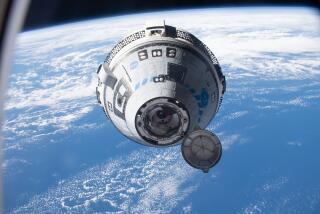Down to Earth
- Share via
Palmdale — It’s time for a tuneup
After flying 60 million miles over 20 missions, the space shuttle Atlantis has arrived at the Boeing Orbiter Major Modification Facility here for a $70-million make-over.
Atlantis will undergo a comprehensive inspection and more than 100 modifications designed to cut maintenance cost, improve shuttle safety and increase its ability to support construction of the International Space Station, officials said.
About 350 engineers and technicians--many of whom built Atlantis--began overhauling the shuttle in November. It is scheduled to return to the Kennedy Space Center in August.
“This is by far the most extensive and complex modification effort ever undertaken on a space shuttle orbiter,” said Allen M. Hoffman, Boeing’s director of Orbiter Major Modifications for Reusable Space Systems. “There is a real pride among the workers, especially when it is launched for the first time after the modification.”
The most significant aspect of the project, officials said, will be the installation of a state-of-the-art cockpit and a satellite-based navigation system.
Work crews will create a “glass cockpit” by replacing Atlantis’ outdated cathode ray tube screens ad mechanical gauges and instruments with full-color, flat-panel glass screens and digital instruments, like those now used in commercial and military planes.
The change is necessary because the present devices are obsolete and expensive to maintain, said Russ Turner, vice president and general manager of Boeing Reuseable Space Systems. Besides reducing maintenance costs, the glass cockpit will reduce vehicle weight and power consumption, improve shuttle reliability and performance and make it capable of expansion for future applications.
Atlantis will also get a satellite-based navigation system as part of its face lift, Turner said. Eventually, the satellite guidance system will replace several ground navigation sites at the Kennedy Space Center and other transatlantic abort landing sites.
Additionally, crews will scour every inch of the shuttle, using borescopes, X-rays and ultrasound technology to search for possible fatigue, corrosion, broken rivets or welds on the 12-year-old ship, Turner said.
Atlantis rolled out of the Palmdale facility in April 1985 and made its maiden voyage into space six months later.
The shuttle has flown missions for the Department of Defense, deployed the Magellan, Galileo and Gamma Ray Observatory spacecraft and docked with Russia’s space station Mir. Its next mission, to deliver hardware to the International Space Station, is scheduled for January 1999.
More to Read
Sign up for Essential California
The most important California stories and recommendations in your inbox every morning.
You may occasionally receive promotional content from the Los Angeles Times.










